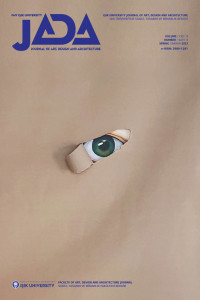Öz
Kaynakça
- Alp, Ö. K. (2013). Sanatın temsili ve postmodern sanatta temsil. Süleyman Demirel Üniversitesi Güzel Sanatlar Fakültesi Hakemli Dergisi, 12, 25-53.
- Constantin Brancusci. (2016). The Endless Column. Retrieved December 2, 2016, from https://www.thehistoryofart.org/constantin-brancusi/endless-column/
- Crowther, P. (2018). Contingent objects, permanent eclecticism. In P. Crowther (Ed.), Geneses of postmodern art: Technology As Iconology (1st ed., pp. 10-28). Routledge.
- EmilieBaltz (2016). Experiments: Lickestra. Retrieved November 20, 2022, from http://emiliebaltz.com/experiments/lickestra/
- Flathery, J. (2014). By licking these electric ice cream cones, you can make music. Wired. Retrieved November 20, 2022, from https://www.wired.com/2014/02/make-music-licking-ice-cream/
- Fondazione Piero Manzoni (2021). 1961 living sculptures. Retrieved November 20, 2022, from https://www.pieromanzoni.org/pieromanzoni/biographies/30/sculture-viventi?lang=en
- İlden, S., & Mutlu, E. (2020). Transformation of esthetics in postmodern art. Alınteri Journal of Social Sciences, 4(1), 39-46.
- Krauss, R. (1979). Sculpture in the expanded field. October, 8(Spring 1979), 30-44.
- Mold. (2013). Lickestra: An interactive ice cream orchestra [Video]. Vimeo. https://vimeo.com/87561228
- Yılmaz, M. (2006). Modernizmden postmodernizme sanat. Ütopya Yayınları.
- Yuan, L.Y. (2014). Lickestra. Retrieved December 2, 2016, from http://www.alldayeveryday.com/articles/lickestra-ice-creamorchestra
Öz
With the aim of understanding the transformation of the pedestal in contemporary art and design through Lickestra as a way of lifting up the experience as the artwork, this study examines the experimental Lickestra project, which is an exemplary, playful artwork, inviting participants and utilizing the simulation of different senses to create the artwork. Throughout the history of art and design, the representational and expressional transformation of artworks has triggered transformations in the form, meaning and function of the pedestal. With the artwork being more reflective of its creator’s artistic expression and the viewer becoming a participant through more physical and imaginative engagement, the pedestal has become an integrated part of the artwork, even with a stronger emphasis on the sensory experience, which has been becoming the artwork itself. This study shows that the viewer is not only the participant but also the performer, the co-creator, and an inseparable constituent of the artwork, participating actively through all senses. Therefore, the function and meaning of the pedestal have changed. It has become both seen and unseen and both material and immaterial, serving for multiple functions and consisting of multiple layers of meaning. Furthering this study may initiate new discussions in the field of art and design in terms of integrating sensory experiences and the potential contribution of the utilization of different senses in interactive consumer products.
Anahtar Kelimeler
Pedestal pedestal-artwork relationship sensory experience interactive consumer product
Kaynakça
- Alp, Ö. K. (2013). Sanatın temsili ve postmodern sanatta temsil. Süleyman Demirel Üniversitesi Güzel Sanatlar Fakültesi Hakemli Dergisi, 12, 25-53.
- Constantin Brancusci. (2016). The Endless Column. Retrieved December 2, 2016, from https://www.thehistoryofart.org/constantin-brancusi/endless-column/
- Crowther, P. (2018). Contingent objects, permanent eclecticism. In P. Crowther (Ed.), Geneses of postmodern art: Technology As Iconology (1st ed., pp. 10-28). Routledge.
- EmilieBaltz (2016). Experiments: Lickestra. Retrieved November 20, 2022, from http://emiliebaltz.com/experiments/lickestra/
- Flathery, J. (2014). By licking these electric ice cream cones, you can make music. Wired. Retrieved November 20, 2022, from https://www.wired.com/2014/02/make-music-licking-ice-cream/
- Fondazione Piero Manzoni (2021). 1961 living sculptures. Retrieved November 20, 2022, from https://www.pieromanzoni.org/pieromanzoni/biographies/30/sculture-viventi?lang=en
- İlden, S., & Mutlu, E. (2020). Transformation of esthetics in postmodern art. Alınteri Journal of Social Sciences, 4(1), 39-46.
- Krauss, R. (1979). Sculpture in the expanded field. October, 8(Spring 1979), 30-44.
- Mold. (2013). Lickestra: An interactive ice cream orchestra [Video]. Vimeo. https://vimeo.com/87561228
- Yılmaz, M. (2006). Modernizmden postmodernizme sanat. Ütopya Yayınları.
- Yuan, L.Y. (2014). Lickestra. Retrieved December 2, 2016, from http://www.alldayeveryday.com/articles/lickestra-ice-creamorchestra
Ayrıntılar
| Birincil Dil | İngilizce |
|---|---|
| Konular | Görsel Sanatlar (Diğer) |
| Bölüm | Eleştiri |
| Yazarlar | |
| Yayımlanma Tarihi | 2 Nisan 2023 |
| Yayımlandığı Sayı | Yıl 2023 Cilt: 1 Sayı: 1 |


